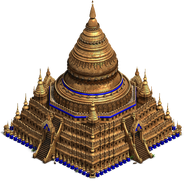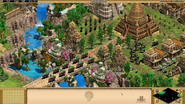The Burmese civilization theme
The Burmese are a Southeast Asian civilization in Age of Empires II HD: Rise of the Rajas. They are based on the Pagan Empire and the later Toungoo Empire and feature as a Monk and elephant civilization.
The region around Burma is well known for their wide mountain ranges with lush valleys and a vast amount of forests. To reflect on this, the Burmese get free upgrades at the Lumber Camp. Buddhism played a huge role for the Burmese, teaching the importance of humbleness, not valuing any wealth and luxuries. This is highlighted with their cheaper Monastery technologies as well as their team bonus that reveals the location of Relics on the map.
The Burmese army were feared horsemen in the region that were able to hold off on their own against the Mongol invasion for a while despite their eventual defeat. More particularly, the Burmese were known for their traditional horseback dart throwing, which is reflected on their unique unit, the Arambai, and one of their unique technologies, Manipur Cavalry.
The Burmese were also known for their use of heavily armored elephants, which is reflected with their other unique technology, Howdah, giving Battle Elephants extra melee armor and pierce armor. And finally, the Burmese foot soldiers were trained martial artists with martial arts such as the Aka and Bando, which is reflected with their infantry getting extra attack with every Age advancement.
Overview
Standing out for the Burmese are their excellent cavalry, most notably Battle Elephants, their strong infantry, and their great Monks. On the downside, their archers are close to being unusable without key upgrades like Thumb Ring, Arbalest, and Leather Archer Armor. The latter is especially unfortunate as their otherwise strong unique unit, the Arambai, direly misses it. Their navy and siege weapons are average with a few missing upgrades that do not too much harm overall. The defensive structures are also rather average, but their economy is strong.
Campaign appearances
The Burmese have a campaign devoted to their civilization: Bayinnaung.
Characteristics
Unique unit
 Arambai: Cavalry with powerful ranged attack
Arambai: Cavalry with powerful ranged attack
Unique technologies
 Howdah: Gives Battle Elephants +1/+1 armor.
Howdah: Gives Battle Elephants +1/+1 armor. Manipur Cavalry: Gives cavalry and Arambai +3 attack against buildings and standard buildings.
Manipur Cavalry: Gives cavalry and Arambai +3 attack against buildings and standard buildings.
Civilization bonuses
- Lumber Camp technologies are free.
- Infantry has +1/+2/+3 attack in the Feudal/Castle/Imperial Age.
- Monastery technologies are 50% cheaper.
Team bonus
- Relics are visible on the map from the game start.
Changelog
Rise of the Rajas
- Initially, Howdah costs 200f/300w and gives Battle Elephants +1/+2 armor. With patch 5.7, Howdah now costs 400f/300w and gives Battle Elephants +1/+1 armor.
- (Elite) Arambai initially have 18 (20) attack, 1.35 speed, and +2 cavalry archer armor.
- With patch 5.7 (Elite) Arambai have 17 (19) attack, 1.3 speed, and no bonus armor against anti-cavalry archer attacks.
- Initially, Manipur Cavalry gives +6 attack against buildings. With patch 5.3, the bonus is spread over the two building classes (building and standard building) equally so Architecture does not cancel the effect completely anymore.
- Arambai initially cost 50 wood and 60 gold. With patch 5.8, they now cost 80 wood and 60 gold.
In-game dialogue
In-game, Burmese units speak Burmese, also known as Myanma bhasa. It is a language related to Chinese and Tibetan.
- Villagers
- Hou'ke (ဟုတ်ကဲ့) - Yes
- Swa do mè (သွားတော့မယ်) - I'm going
- Musoe (မုဆိုး) - Hunter
- Laysama (လယ်သမား) - Farmer
- Monks
- Hou'ke (ည့်တော်) - Yes
- Chechim badè! (ပါတယ်)
- Military
- Hou'ke (ဟုတ်ကဲ့) - Yes
AI player names
When playing a random map game against the computer, the player may encounter any of the following Burmese AI characters:
- Anawrahta: The founder of the Pagan Empire. Considered the father of the Burmese nation, Anawrahta turned a small principality in the dry zone of Upper Burma into the first Burmese Empire that formed the basis of modern-day Burma.
- Bayinnaung: Bayinnaung Kyawhtin Nawrahta was king of the Toungoo Dynasty of Burma from 1550 to 1581. During his 31-year reign, which has been called the "greatest explosion of human energy ever seen in Burma," Bayinnaung assembled the largest empire in the history of Southeast Asia, which included much of modern-day Burma, Chinese Shan states, Lan Na, Lan Xang, Manipur, and Siam.
- Binnya Dala: A court title used at the courts of the Hanthawaddy Kingdom, Toungoo Dynasty and Restored Hanthawaddy Kingdom. Possibly refers to General of Hanthawaddy defeated in the Battle of Naungyo in 1538 or Chief Minister and general of Toungoo (1559–1573).
- Kyansittha: King of Pagan dynasty of Burma from 1084 to 1112/13, and is considered one of the greatest Burmese monarchs.
- Min Bin: King of Arakan from 1531 to 1554, "whose reign witnessed the country's emergence as a major power". Aided by Portuguese mercenaries and their firearms, his powerful navy and army pushed the boundaries of the kingdom deep into Bengal, where coins bearing his name and styling him sultan were struck, and even interfered in the affairs of mainland Burma.
- Mingyi Nyo: The founder of Toungoo dynasty of Burma. Under his 45-year leadership (1485–1530), Toungoo (Taungoo), grew from a remote backwater vassal state of Ava Kingdom to a small but stable independent kingdom.
- Minkhaung: A Burmese royal title, and may refer to monarchs (kings Minkhaung I/Minkhaung II/Minkhaung of Mrauk-U/Minkhaung of Prome) or viceroys of Toungoo (Minkhaung I of Toungoo/Minkhaung II of Toungoo) in late AoE II era.
- Nanda: King of Toungoo Dynasty of Burma from 1581 to 1599. He presided over the collapse of Toungoo Empire, the largest empire in the history of Southeast Asia.
- Narapati: A Burmese royal title, and may refer to: Narapati I of Ava, King of Ava, r. 1442–68; Narapati II of Ava, King of Ava, r. 1501–27; Narapati of Prome, King of Prome, r. 1532–39; Narapati III of Ava, King of Ava, r. 1545–51; and Narapati IV of Ava, King of Ava, r. 1551–55; in AoE II era.
- Sithu: A Burmese royal title used in the days of Burmese monarchy and may refer to Sithu I/Sithu II/Sithu III/Sithu IV, kings of Pagan, Sithu of Pinya and Sithu Kyawhtin.
- Swasawke: King of Ava from 1367 to 1400. He reestablished central authority in Upper Burma for the first time since the fall of the Pagan Empire in the 1280s. He essentially founded the Ava Kingdom that would dominate Upper Burma for the next two centuries.
- Tabinshwehti: Tabinshwehti was king of Toungoo Dynasty of Burma from 1530 to 1550, and the founder of Toungoo Empire. His military campaigns created the largest kingdom in Burma since the fall of Pagan Empire in 1287.
Trivia
- The Burmese are the only civilization that lack Leather Archer Armor at the Blacksmith.
- While they primarily represent the Pagan Kingdom and the Taungoo/Toungoo dynasty, they also draw influence from modern northeastern India, namely the state of Manipur, reflected in their use of the Arambai and the Manipur Cavalry unique technology. This is slightly ironic, as the Kingdom of Manipur often fought against the Burmese Empire, although also a bit justified: Manipur horsemen often fought in Burmese armies and constituted important portions of the Burmese cavalry.
- If a player picks the Burmese civilization, the bottom middle of the navigation bar will show an image of peacock based from the royal symbol of Burmese kingdoms since the 11th century.
Gallery
Video overview

Burmese Overview AoE2





